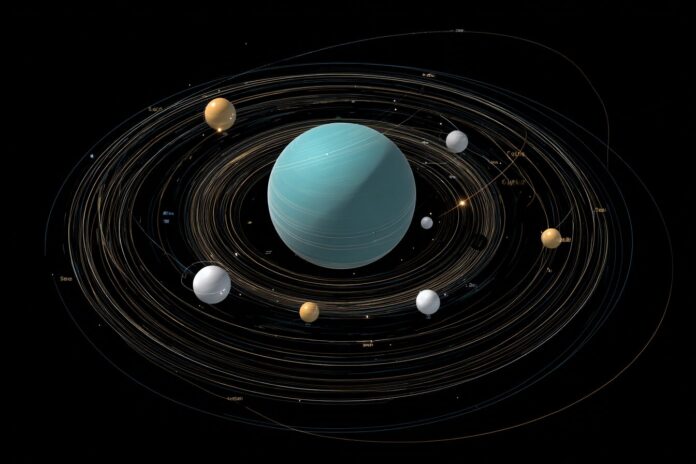Unveiling Uranus’s Hidden Companion with the Webb Telescope
In an astronomical breakthrough, NASA’s James Webb Space Telescope (JWST) has uncovered a previously unknown moon orbiting Uranus. This discovery, made in August 2025, redefines our understanding of Uranus’s dynamic satellite system. Most importantly, it showcases how cutting-edge technology can reveal secrets hidden in the outer reaches of our solar system. Because of its sophisticated instruments, JWST is enabling scientists to explore cosmic phenomena that remain undetectable by older telescopes.
Moreover, the finding emphasizes the ongoing commitment of space agencies like NASA, SETI Institute, and ESA to expand our cosmic horizons. Therefore, each new observation adds layers to our knowledge, bridging past observations with modern exploration methods. Besides that, the discovery encourages further research into the formation and evolution of icy moons and ring systems.
A Milestone Observation: The Birth of a New Chapter in Uranian Studies
The discovery of the new moon, provisionally named S/2025 U1, marks a milestone observation led by the Southwest Research Institute (SwRI). Utilizing Webb’s Near-Infrared Camera (NIRCam), astronomers captured a series of ten 40-minute long-exposure images on February 2, 2025, which revealed the moon’s faint signal. Because the exposures were meticulously stacked, researchers could extract details from objects that were previously hidden by Uranus’s brightness and complex ring structure, as noted by NASA’s official release (NASA Science).
This tiny moon, measuring only about 6 miles (10 kilometers) in diameter, had evaded detection even during Voyager 2’s flyby in 1986 and subsequent ground-based observations. Most importantly, its discovery reaffirms the enhanced capabilities of the JWST, which can integrate faint signals over long periods—a technique that makes this breakthrough possible.
Expanding Uranus’s Satellite Family: More Than Just a Count
S/2025 U1 brings the total count of Uranus’s moons to an impressive 29. This addition not only highlights the planet’s intricate and crowded satellite system but also sparks new questions about orbital dynamics and formation history. Because the new moon orbits approximately 35,000 miles (56,000 km) from Uranus’s center, its path is both intimate and intriguing, nestled among a cluster of other small inner moons, as detailed by recent analyses on Space.com.
Moreover, the discovery of such a diminutive and faint object provokes a re-evaluation of our current models of moon formation. Therefore, scientists are now more inclined to believe that Uranus’s inner satellites may have formed in situ, rather than being captured, which has significant ramifications for our understanding of the planet’s past.
Technological Triumph: How JWST Transformed Astronomical Observation
The unparalleled sensitivity of the James Webb Space Telescope is the cornerstone of this discovery. Its NIRCam instrument allowed astronomers to pierce through the complex glare of Uranus’s rings and atmosphere, capturing subtle, near-infrared signals that previous missions could not register. Most importantly, this technological leap demonstrates how modern telescopes enable us to see deeper into cosmic domains that were once shrouded in mystery.
Because of advanced image processing techniques, including stacking of multiple exposures, the JWST could isolate the weak signal from S/2025 U1. Therefore, aside from unveiling a new moon, these methods have shed light on the finer structures of Uranus’s rings and other nearby satellites. This breakthrough is emphasized by the SETI Institute (SETI Institute) and further highlighted by ESA’s detailed imagery (ESA Webb), stressing the interdisciplinary cooperation in space exploration.
Implications for Uranian Science and Beyond
The discovery of S/2025 U1 not only deepens our understanding of Uranus’s satellite system but also impacts planetary science. Because the new moon is one of the smallest and faintest detected so far, it provides clues to a potentially larger population of hidden bodies orbiting the ice giant. Besides that, it enriches the narrative of how Uranus’s unique formation—shaped by its extreme axial tilt and complex ring system—may have fostered the birth of several minor moons over time.
Most importantly, this finding encourages the scientific community to revisit theories concerning moon formation and orbital evolution. Therefore, it offers a tangible case study for researchers examining the intertwined history of moons and rings. In addition, continuous monitoring and analysis, as shared on social media platforms like Instagram, keep enthusiasts and scientists alike updated on the latest cosmic developments.
Looking Ahead: Further Discoveries on the Frontier of the Solar System
With every new observation, our comprehension of Uranus’s satellite system becomes more nuanced. The detection of S/2025 U1 is an invitation to explore further and ask deeper questions about the processes that govern the formation of moons around icy giants. Most importantly, this discovery paves the way for future missions and continued observation using JWST’s myriad of instruments.
Because ongoing studies will likely reveal more hidden moons and perhaps even smaller fragments within Uranus’s rings, astronomers remain hopeful. Therefore, upcoming data from JWST’s extended Uranus campaigns may unearth further cosmic surprises. In this evolving saga of discovery, each new observation contributes significantly to our collective understanding of the solar system’s outer realms.
For continuous updates on this groundbreaking discovery and other advancements in planetary science, visit trusted sources such as NASA Science, the SETI Institute, and dedicated imagery at ESA Webb. Such collaborations underscore the collective effort driving space exploration today.



